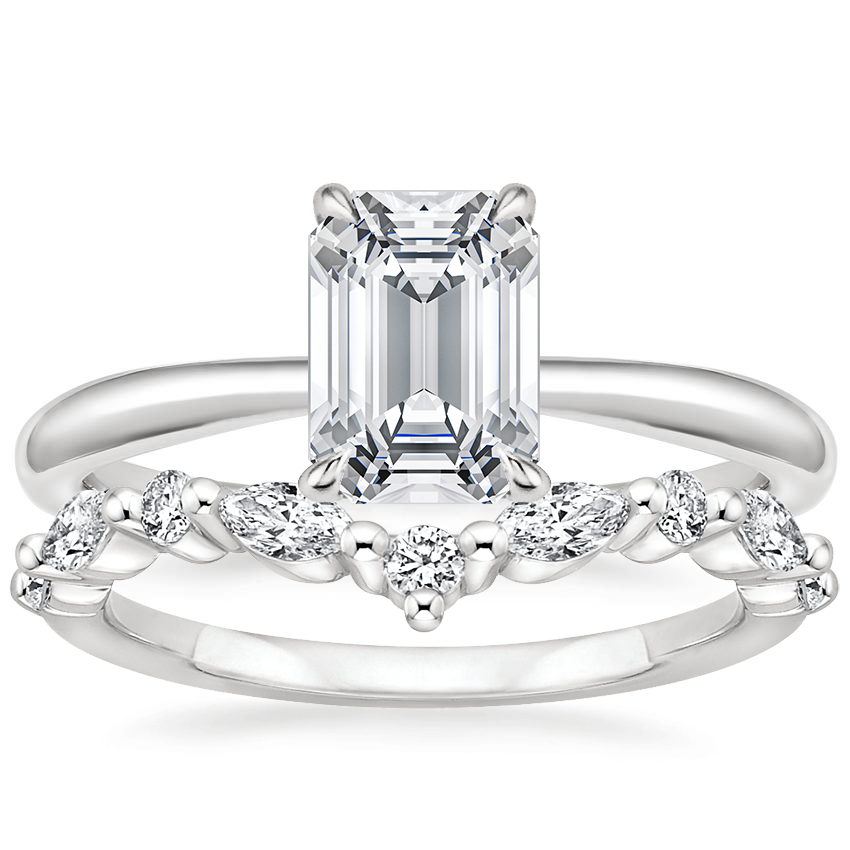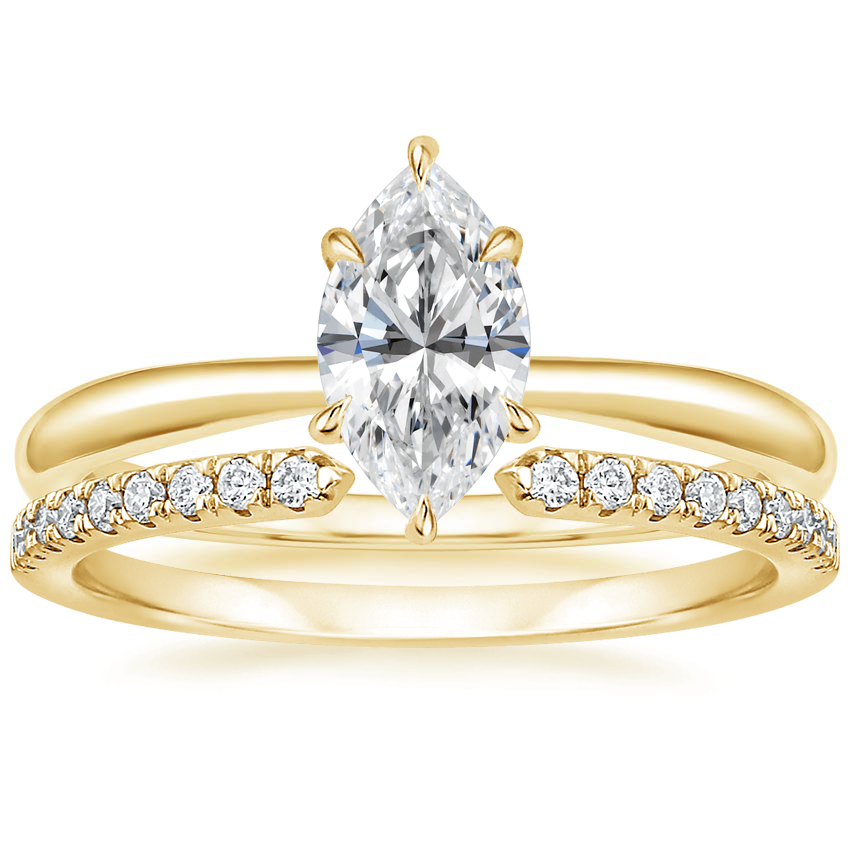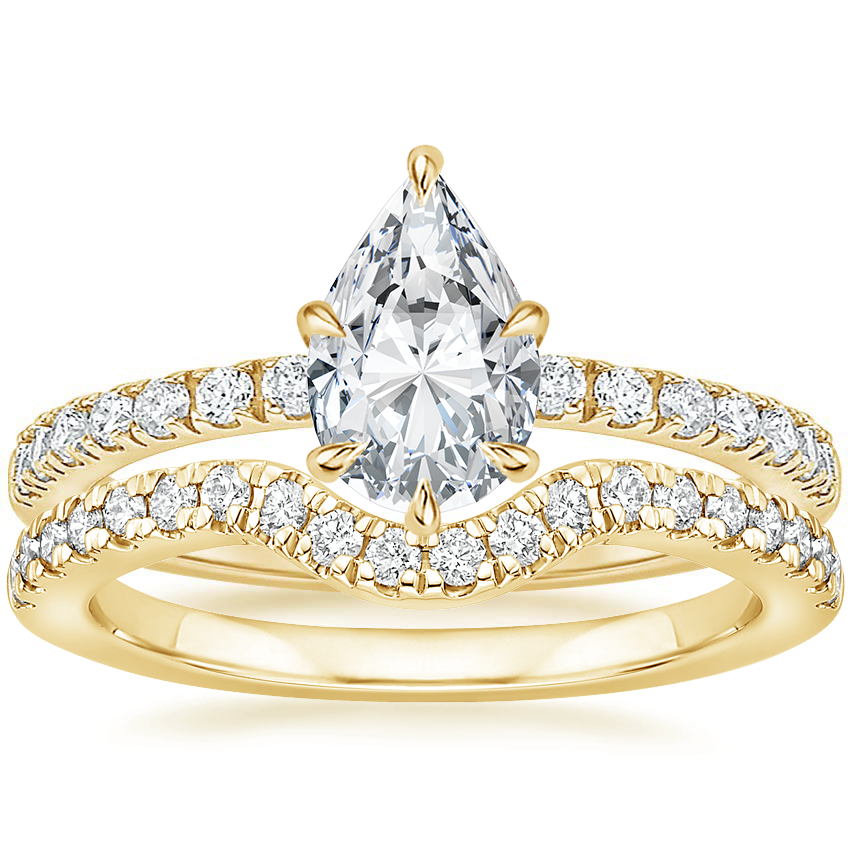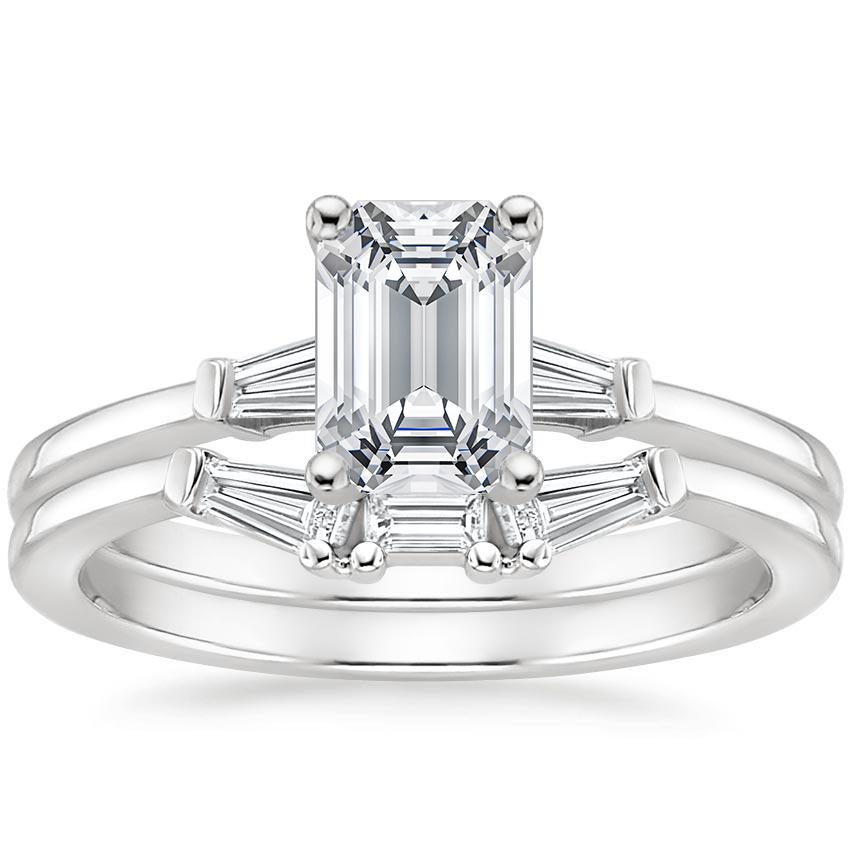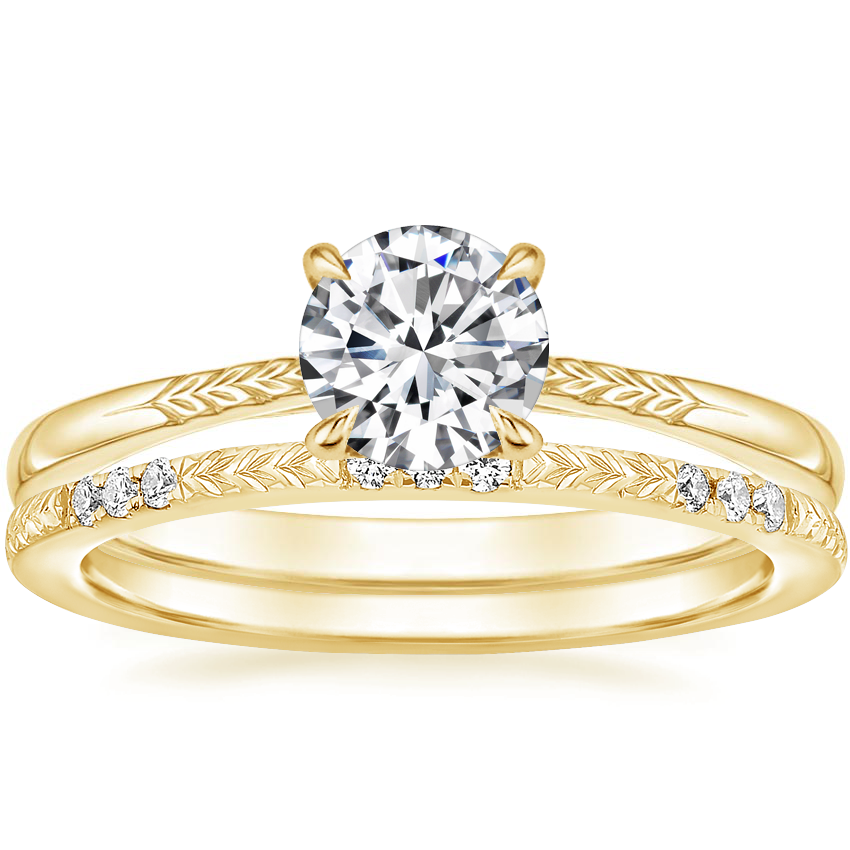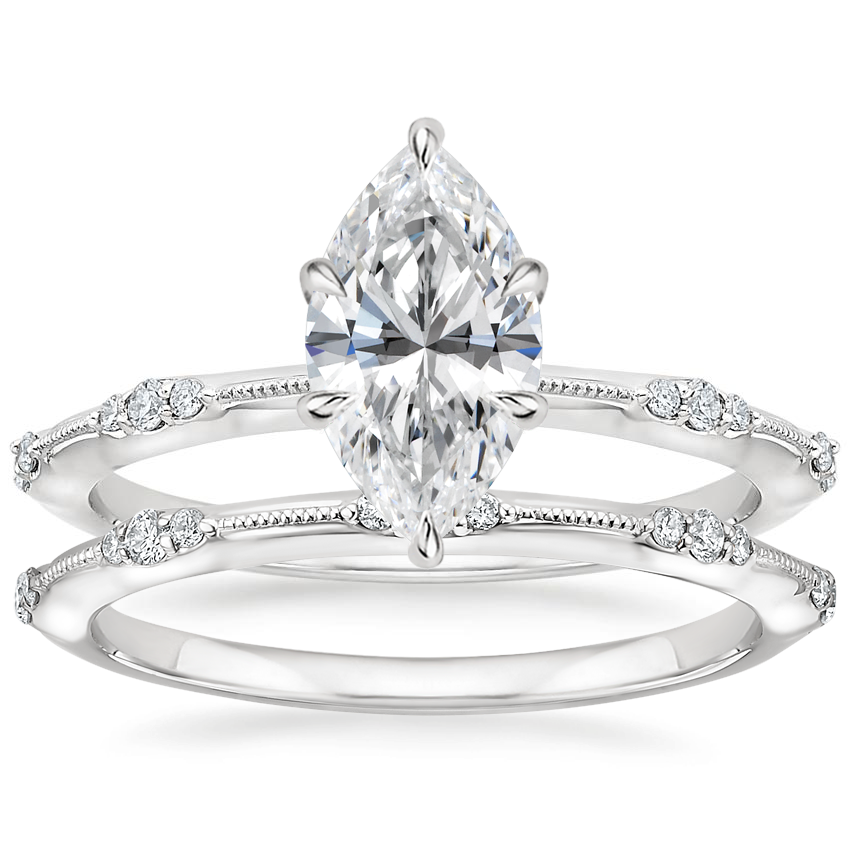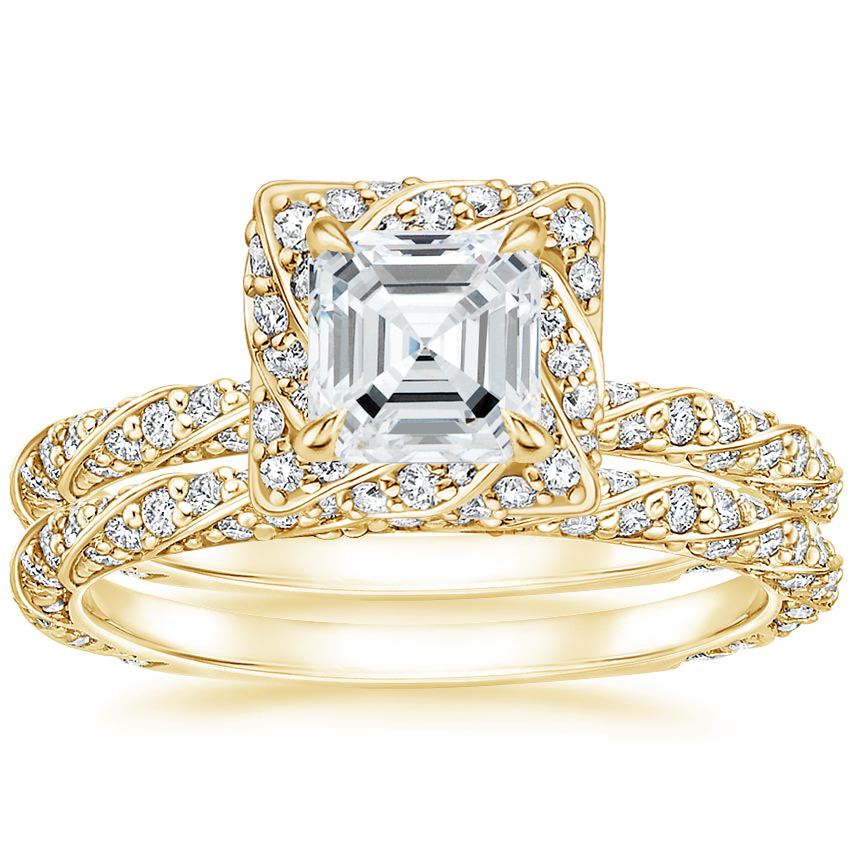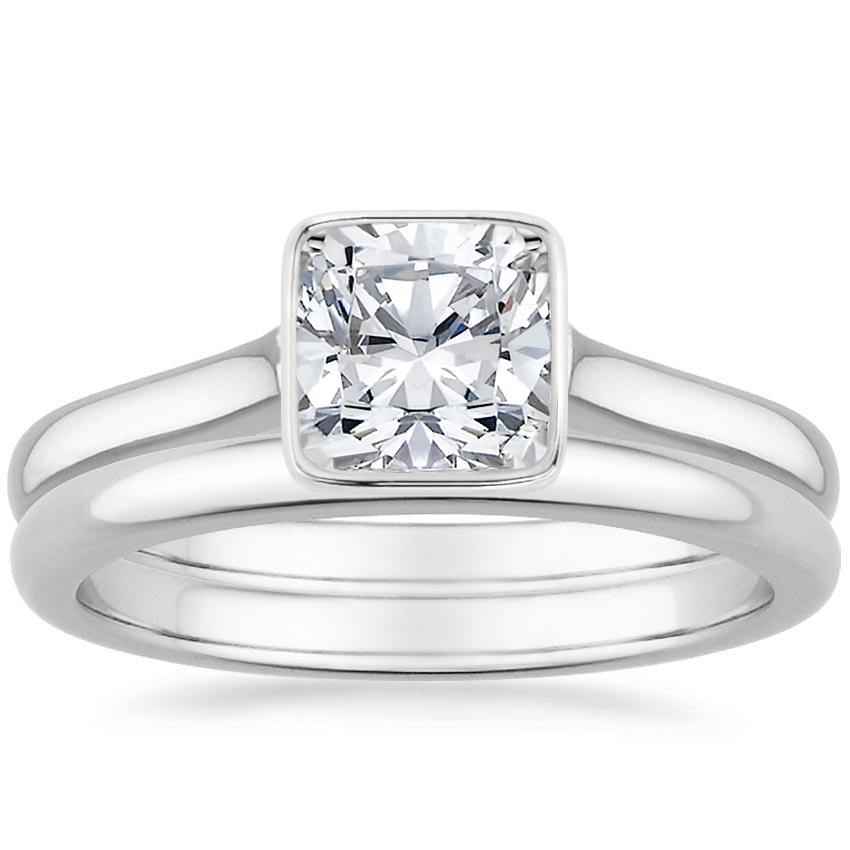
Finding the perfect wedding band to match your engagement ring is like finding the missing piece of your bridal puzzle. Your engagement ring symbolizes your intention to tie the knot, while the wedding band represents your lifelong commitment.
If your engagement ring has a unique design with fancy stone shapes or settings, it may seem challenging to find the perfect match. But don’t worry! There are plenty of options available, like contoured wedding bands or ring jackets, that can beautifully complement your engagement ring.
Even if your engagement ring doesn’t come with a matching band, your jeweler can offer excellent suggestions. It might take some time and effort to find the right pairing, but trust us, it’s worth it. After all, you’ll proudly wear this duo for a lifetime.
So, where do you start? Read on to discover our stylists’ tips on how to create your dream bridal set.

How to Pick a Wedding Band that Complements Your Engagement Ring
Step 1: Select a metal
Traditionally, it’s common to choose a wedding band that matches the metal type of your engagement ring. However, mixed-metal bridal sets are gaining popularity. Mixing white, yellow, and rose gold can create a stunning and unique combination. To help you find the best metal combination for your bridal set, our Find My Matching Wedding Ring tool is a great starting point.
Step 2: Decide if a flush fit is important to you
Determining whether a flush fit is important to you will help you decide what type of wedding band you want. A flush fit wedding ring sits level with the engagement ring, creating a seamless and integrated appearance. If you are having trouble finding a straight band to sit flush with your engagement ring, you can still achieve the look by opting for a curved or contoured band that neatly fits around the center stone or setting of the engagement ring.
Open bands that have a gap can also help create a flush fit look by allowing the center stone of your engagement ring to nestle in the wedding band’s gap. Open and curved rings offer aesthetic appeal, comfort, and protection to your engagement ring. However, they have limited adjustability when it comes to resizing.
While the stacked, flush-fitting engagement ring and wedding band have become something of a modern tradition, don’t forget that we are making our own traditions all the time! And a gap between an engagement ring and wedding band was the classic look for decades before that. If a flush fit doesn’t appeal to you, consider wearing your rings on separate hands or with a gap between them. Remember, each ring has its own distinct features and deserves individual attention.
Step 3: Select a wedding band type
With numerous options available, it’s essential to find a wedding band style that reflects your personality and enhances the beauty of your engagement ring. Let’s explore some of the most popular types of wedding bands:
- Stacking Bands: Versatile and customizable, these bands can be worn together on the same finger as the engagement ring, allowing you to mix and match different designs, gemstones, and textures.
- Contoured Bands: These bands are designed to match the curvature of your engagement ring, creating a modern and unique twist to your bridal set.
- Classic Plain Metal Bands: Timeless and elegant, these bands are made from precious metals like gold, silver, platinum, or titanium, and are perfect for those who prefer a minimalist and traditional style.
- Notched Bands: These special bands have a small groove or cutout, allowing them to sit perfectly alongside an engagement ring or another band, creating a comfortable and stylish fit.
- Diamond Bands: Adorned with sparkling diamonds, these bands can have diamonds partially or entirely encircling the band, adding extra brilliance and glamour to your ring finger.
- Ring Jackets: Enhance the appearance of your engagement ring with these bands that surround it on either side, featuring additional diamonds, gemstones, or intricate designs.
- Open Bands: With an opening or gap at the top, these modern and contemporary bands can be left empty or adorned with diamonds or gemstones, offering a fresh and distinctive twist on the traditional wedding band.

How to Choose a Wedding Band for Your Engagement Ring Type
Now let’s explore some styling tips for popular engagement ring styles and center stone cuts:
What wedding band goes with an emerald cut engagement ring?
The step cut of an emerald diamond center stone exudes a subdued sparkle compared to other shapes. To enhance its brilliance, we suggest pairing your emerald cut engagement ring with a wedding band featuring round or other fancy-shaped diamonds, such as oval or marquise. This combination will add extra brilliance and create a stunning ensemble.
What wedding band goes with a marquise engagement ring?
The curving, oblong shape of a marquise cut diamond is flattering and distinctive. To highlight the unique silhouette of a marquise diamond engagement ring, consider an open band or ring jacket. These options beautifully showcase the marquise shape. Another choice is a simple straight band with a row of small diamonds or gemstones that mirror the shape of your marquise stone.
What wedding band goes with an oval engagement ring?
When it comes to pairing a wedding band with an oval engagement ring, you have plenty of options to choose from! The elongated shape of the oval engagement ring offers versatility, allowing you to experiment with different band styles. One popular choice is a curved wedding band that complements the curves of the oval ring, creating a lovely and seamless look. If you prefer a classic and elegant pairing, a plain band is a perfect option. For those who desire a touch of sparkle, a diamond band featuring oval-shaped diamonds can provide a cohesive pairing.
What wedding band goes with a pear engagement ring?
A popular choice for a pear engagement ring is a notched wedding band. These bands feature a small notch or curve that perfectly accommodates the shape of your pear engagement ring. They create a stunning pairing, allowing your engagement ring to sit snugly against the band for a cohesive and elegant look. Another fantastic option is a ring jacket. These versatile bands surround your pear shaped diamond, adding extra sparkle and creating a breathtaking ensemble. With various styles available, from simple and sleek to intricately designed, you’ll find the perfect match for your personal taste.
What wedding band goes with a three stone engagement ring?
For a three stone engagement ring, you have a couple of excellent options. One popular choice is a simple and classic diamond band that matches the size and shape of the diamonds in your engagement ring. This creates a cohesive and elegant look that will never go out of style. Another option is a contoured wedding band specially designed to fit around the curves of your three stone ring. If you prefer a more personalized touch, you can also consider a custom-designed wedding band that incorporates elements from your engagement ring, such as matching metalwork or gemstone accents.
What wedding band goes with a solitaire engagement ring?
A solitaire engagement ring is the most common and versatile style out there. Fortunately, there are numerous options that beautifully enhance the elegance of your solitaire ring. Whether your center stone is round, cushion, radiant, asscher, princess, or any other shape, a solitaire engagement ring pairs well with various wedding ring styles. For a classic look, opt for a simple metal band. If you want to add sparkle and glamour, consider a diamond-accented band. With a solitaire engagement ring, you can’t go wrong with any wedding band choice!
What wedding band goes with a hidden halo engagement ring?
When it comes to finding the perfect wedding band for your hidden halo engagement ring, there are a few important factors to consider. First, you need to decide whether you want to enhance the halo effect or create a contrasting look. If you want to enhance the halo, your best choice is a delicate, curved band that mirrors the shape of the hidden halo. This will create a cohesive and elegant look that complements your engagement ring beautifully. On the other hand, if you prefer a contrasting look, you should consider a straight or geometric band with minimal embellishments. This will provide a sleek and modern touch that adds a unique twist to your ring combination.
What wedding band goes with a halo ring?
A halo ring is already stunning on its own, so when it comes to choosing a wedding band, simplicity is key. Opt for a simple and elegant band that doesn’t overpower the halo setting. Since the halo already adds a touch of glamour and sparkle, a more understated wedding band will beautifully balance the overall look. Classic metal bands like platinum, white gold, or yellow gold are great choices for creating a timeless and harmonious combination. Alternatively, you can choose a delicate diamond-accented band that matches the smaller stones in your halo setting. This will enhance the brilliance of your engagement ring while adding a touch of extra sparkle for that extra wow factor.
What wedding band goes with a bezel set engagement ring?
If you have a bezel set engagement ring, a simple and sleek metal band is a popular choice. This classic style allows the focus to remain on the stunning bezel setting of your engagement ring. The clean lines of a metal band beautifully complement the bezel, creating a cohesive and sophisticated look. If you’re looking for a bit more sparkle, you can opt for a band with small accent diamonds or gemstones that match the ones in your engagement ring. This will add a touch of brilliance while still maintaining the sleekness of the overall design.
Wedding Band Pairing FAQs
What wedding band goes with my ring?
One of our most frequently asked questions is, “which wedding band looks best with my engagement ring?”. Like your engagement ring, a wedding band is a piece you will wear every day and should reflect your personal style. Our Find My Matching Wedding Ring tool can help with your decision by allowing you to see your engagement ring paired with any Brilliant Earth wedding ring to find your perfect match. If you are opting for a stacked or nested bridal look, our Create Your Own Ring Stack tool allows you to see up to three wedding rings stacked with your engagement ring for endless styling options. Our Jewelry Specialists are also ready to lend their expertise in a personalized appointment to help you find your dream bridal set – both virtually and in person!
Are Engagement Rings Supposed to Match Wedding Bands?
There are no strict rules when it comes to matching your engagement ring and wedding band. It all depends on your personal style and preferences. While some people prefer a perfectly matched set, others like to get creative and combine different metal types, diamond shapes, textures, and band widths. Don’t be afraid to experiment and find a combination that reflects your unique taste and showcases your individuality.
How do you combine a wedding ring and engagement ring?
If you want to combine your wedding ring and engagement ring, soldering is a great option. Ring soldering is a technique used to join different parts of a ring together using heat and a special metal called solder. A jeweler will carefully position the two rings exactly where they should be. Next, the jeweler heats the soldering tool and applies it to the joint where the rings meet. The heat melts the solder, and as it cools down, it hardens and fuses the rings together, creating a strong bond. Finally, the jeweler polishes the soldered area to make it smooth and shiny, so it blends seamlessly with the rest of the ring. It’s important to note that if you have a particularly intricate ring design or many pavé diamond accents, your jeweler may not be able to solder your rings together.
How do you keep a wedding band and engagement ring together without soldering?
If you want to keep your wedding band and engagement ring together without soldering them, there are a few stylish options to consider. One popular choice is a ring jacket, also known as a ring guard or ring wrap. These special bands can be placed around both rings, securely keeping them together. Another option is a ring spacer, a small piece of jewelry that fits between the two rings and holds them in place. Additionally, you can explore a ring connector, which is a decorative piece that connects the two rings with a chain or a loop. This way, you can keep your rings close to each other.
Final Thoughts
Whether you prefer a sleek and simple design or a more elaborate and dazzling look, there’s a wedding band out there to suit every taste. Explore Brilliant Earth wedding rings to discover all your options.


